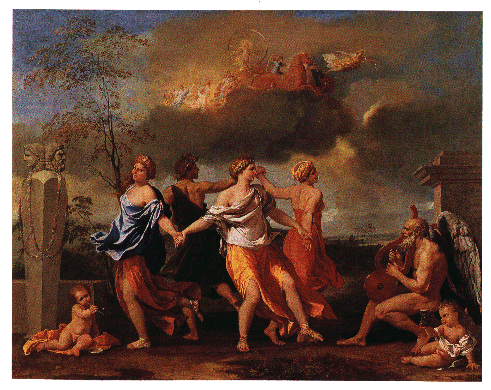|
Composers

Rameau

Purcell

Haydn

Mozart

Beethoven
|
 Rondo
An instrumental form based on a
repeating section, but between every appearance of this section, a new
composition is deployed. Therefore, it can
be described as a strophic form or an a-b-a-c-a... structure. The source
of its name is an ancient French
Rondo
An instrumental form based on a
repeating section, but between every appearance of this section, a new
composition is deployed. Therefore, it can
be described as a strophic form or an a-b-a-c-a... structure. The source
of its name is an ancient French dance. The rondo form is one of the most widely
accepted forms in music, since it combines the reprise of a known section
with the diversity and novelty of new parts that keep coming. Thus it is
used in works by Rameau
dance. The rondo form is one of the most widely
accepted forms in music, since it combines the reprise of a known section
with the diversity and novelty of new parts that keep coming. Thus it is
used in works by Rameau ,
Couperin ,
Couperin and other. A famous rondo is the one in Purcell's
and other. A famous rondo is the one in Purcell's drama "Abdelazer"
drama "Abdelazer"  .
Among composers of the classic .
Among composers of the classic era, such as Haydn
era, such as Haydn ,
Mozart ,
Mozart  and Beethoven
and Beethoven ,
it evolved into a form called "rondo-sonata" ,
it evolved into a form called "rondo-sonata" which is a combination of the rondo principle
with the sonata (simply, it is a sonata with
an additional appearance of section 'A' before the development unit). The
structure of this form is a-b-a-c-a-b-a.
Note that many works are not titled
"rondo", yet they are built as one.
For example, different mazurkas
which is a combination of the rondo principle
with the sonata (simply, it is a sonata with
an additional appearance of section 'A' before the development unit). The
structure of this form is a-b-a-c-a-b-a.
Note that many works are not titled
"rondo", yet they are built as one.
For example, different mazurkas ,
bagatelles ,
bagatelles ,
waltzes ,
waltzes and impromptus
and impromptus were written in the rondo structure.
One must not confuse this with
the medieval
were written in the rondo structure.
One must not confuse this with
the medieval rondeau
rondeau ,
a polyphonic song that lacked the structure that characterised the rondo
since the 17th century. ,
a polyphonic song that lacked the structure that characterised the rondo
since the 17th century.

|
Xtend
 Listen
Listen
 Period
Period
 Notes
Notes
 Scheme
Scheme
 Dictionary
Dictionary
 Internet
Internet
 Projects
Projects
 Finders
Finders
|